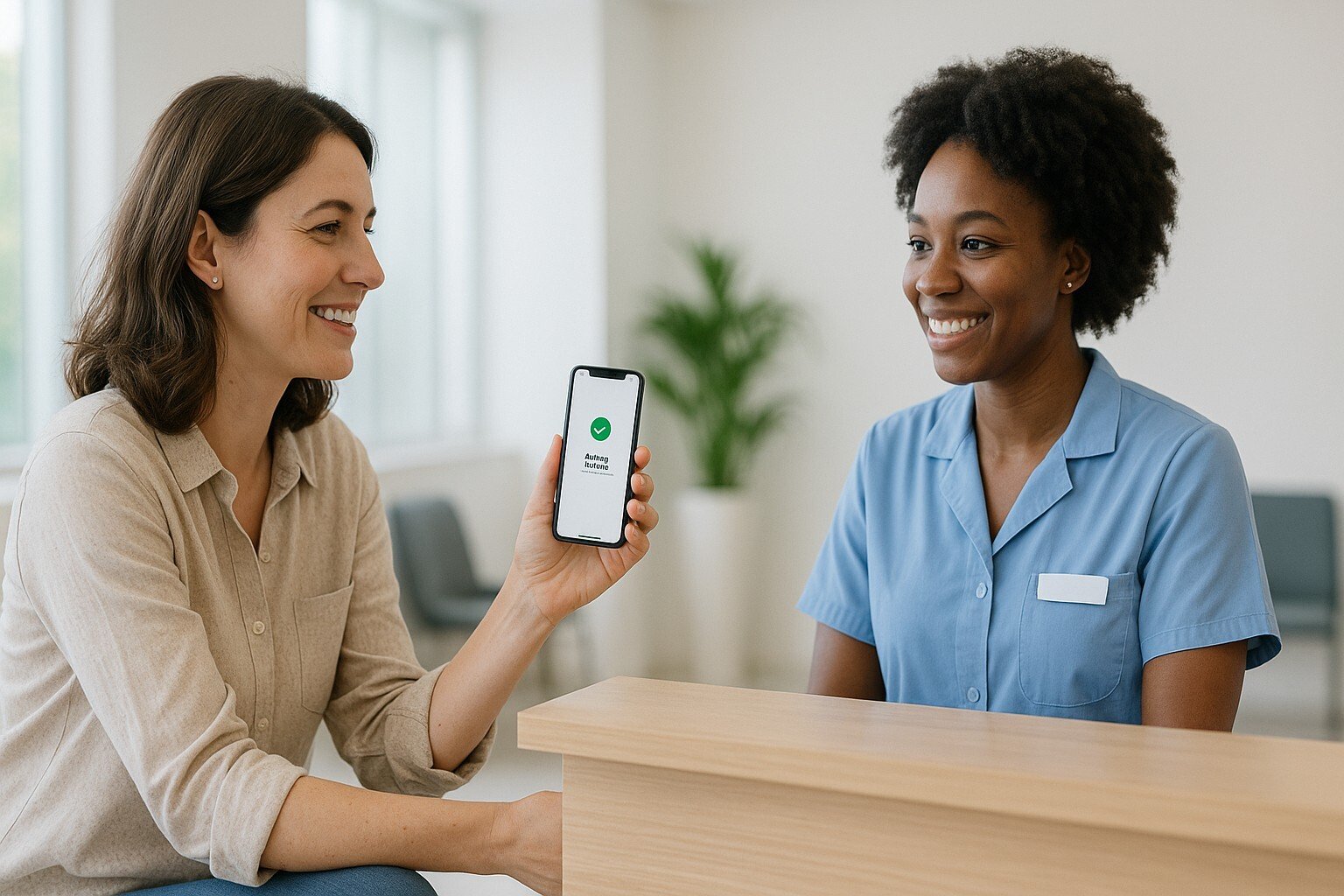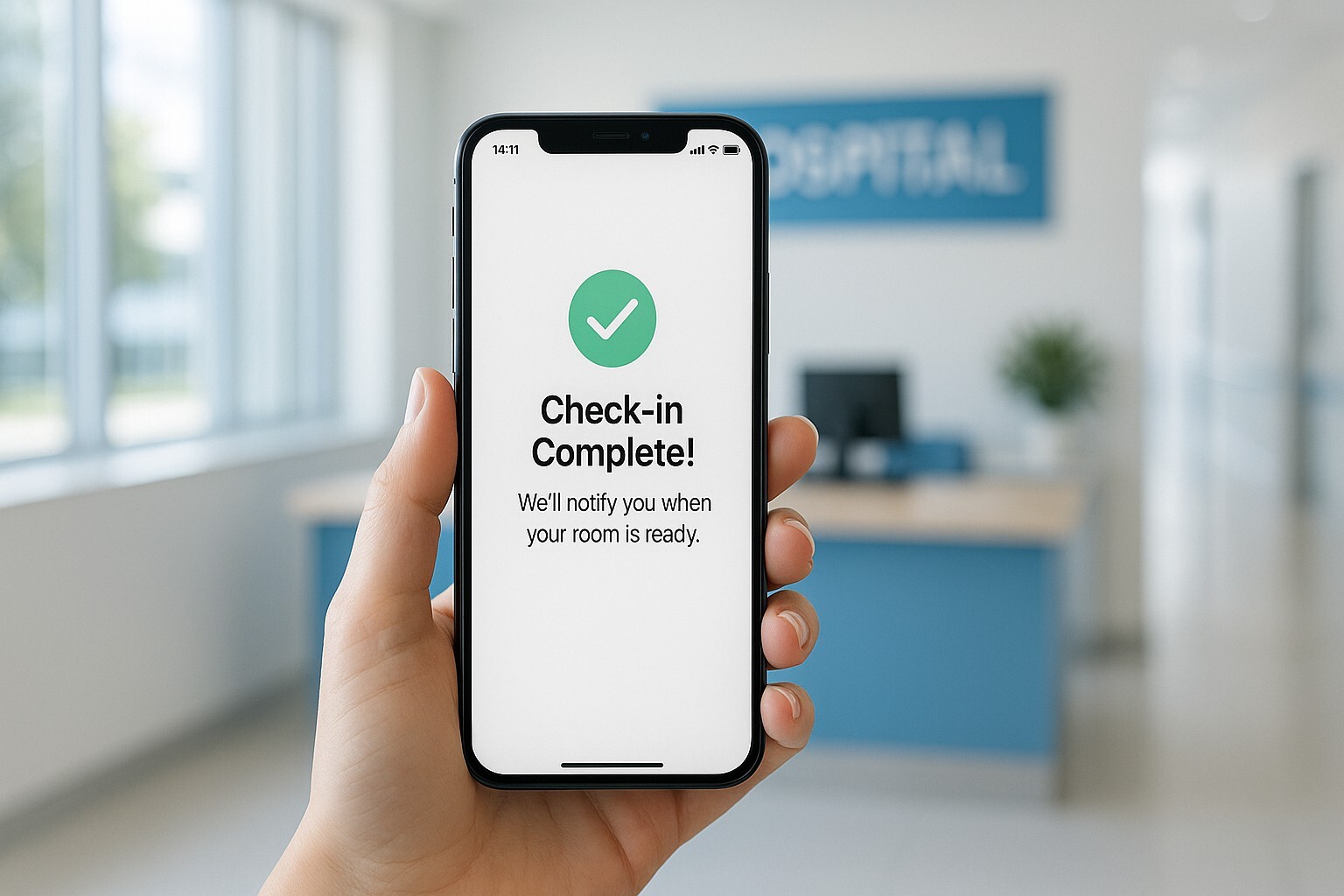The Ultimate Guide to Contactless Patient Check-in and Contactless Hospital Check-in
A contactless patient check-in system allows patients to complete registration, forms, and payments from their own device before arriving,...
6 min read
Alvin Amoroso : 8/4/25 7:11 AM

In today's on-demand world, patients expect more. They manage their finances, book travel, and order groceries with a few taps on their phone, and they now demand that same level of convenience from their healthcare providers. The old reality of the clipboard, crowded waiting rooms, and redundant paperwork no longer meets this expectation. This disconnect between patient expectation and practice reality isn't just a source of frustration; it directly impacts your bottom line through inefficiency, errors, and patient churn.
The solution is a strategic shift to contactless patient intake. This isn't just another piece of software; it's the engine that powers an entirely new, modern patient journey. By replacing analog processes with a seamless digital experience, your practice can finally provide the intake experience patients expect while unlocking the efficiency and profitability your business appreciates. This guide will walk you through that new journey and reveal the powerful impact it has on your practice's operational and financial health.
Think about the last time you booked a flight. You likely received a notification on your phone, checked in online, got a digital boarding pass, and walked straight to the gate. It was easy, fast, and put you in control.
Now, contrast that with the traditional patient intake process:
This experience is the definition of friction. It’s slow, inefficient, and feels profoundly outdated. For the modern patient, this isn't just a minor inconvenience; it's a signal that the practice isn't keeping pace with the times. This initial, frustrating experience sets a negative tone for the entire visit and can be the deciding factor when that patient considers choosing another provider in the future. Closing this "satisfaction gap" is no longer optional for practices that want to thrive.
Imagine a completely different experience for your patients—one that is smooth, respectful of their time, and digitally native from start to finish. A contactless patient intake platform doesn't just digitize your old forms; it redesigns the entire pre-appointment workflow. Here’s what that new journey looks like.
The journey begins days before the appointment. Instead of a simple reminder call, the patient receives a text message or email with a secure link. Tapping it opens a simple, mobile-friendly interface on their own device.
From the comfort of their home, they can:
This initial contactless patient registration stage transforms a 15-minute in-office chore into a 5-minute task they can complete whenever they want. They arrive for their appointment feeling prepared, in control, and positive about the experience ahead.
When the patient walks through your door, 95% of the administrative work is already done. The check-in process becomes a simple, quick verification: "Hi, Sarah. We have all your information. The doctor will be with you shortly."
There are no clipboards, no lines, no fumbling for insurance cards. The waiting room transforms from a holding pen into what it should be: a brief, calm transition space. This immediately reduces foot traffic, minimizes potential exposure to illnesses, and creates a safer environment for both patients and your frontline staff. It’s a powerful first impression that communicates efficiency and respect for the patient's time.
The benefits of contactless patient intake flow directly into the exam room. Because all the information was collected and integrated into the EHR before the visit, your clinical team is fully prepared.
This streamlined clinical workflow means providers can be more efficient and effective, leading to better care and the ability to stay on schedule throughout the day.
The journey doesn't end when the patient leaves the exam room. The contactless experience can extend to the checkout process as well. Any remaining balances can be handled digitally via a payment link sent to their phone, avoiding another line at the front desk. Follow-up appointments can be scheduled through a patient portal or automated messaging, completing a truly seamless, end-to-end digital experience.
A better patient journey is great, but a modern practice needs to see a tangible return on investment. This is where a contactless patient intake platform truly shines, directly impacting your bottom line in several key areas.
Think about the hours your staff spends printing forms, deciphering handwriting, manually typing data into the EHR, and scanning documents. A conservative estimate is 5-10 minutes of administrative work per patient. For a practice seeing 40 patients a day, that's over 3 hours of lost productivity every single day. That adds up to more than 60 hours a month—the equivalent of a part-time employee's salary spent on low-value, manual tasks. Contactless intake automates this entire process, freeing your staff to focus on high-value activities like patient communication, managing recalls, and improving the overall service experience.
Collecting payments at the time of service is a major challenge for most practices. Awkward financial conversations at the front desk often lead to delayed or missed payments. By integrating payment collection into the pre-visit intake process, you move the transaction to a private, low-pressure digital environment. Patients know their responsibility upfront and can pay easily. As a result, practices using integrated pre-visit payment solutions often see a 15-20% lift in their collection rate, dramatically improving cash flow and reducing the time spent chasing down outstanding balances.
No-shows are a silent killer of practice revenue. An engaged patient is less likely to miss an appointment. The contactless patient intake process inherently drives engagement. It opens a digital line of communication, sends automated reminders, and gives patients a stake in their appointment by having them complete tasks beforehand. This sense of preparation and two-way communication makes the appointment a firm commitment, often leading to a significant reduction in costly no-show rates.
A single typo in an insurance ID number or date of birth can lead to a costly and time-consuming claim denial. Manual data entry is rife with these errors. A digital intake system ensures the data entered by the patient is the data that goes onto the claim. This level of accuracy leads to cleaner claims, faster reimbursement from payers, and less time your billing staff spends on frustrating denial management.
To achieve these results, you need more than just a simple forms tool. You need a complete platform built on three pillars:
Contactless check-in allows patients to complete all administrative tasks like forms and payments digitally on their own device before an appointment. Contactless check-out extends this convenience to post-visit activities like paying remaining balances and scheduling follow-ups, minimizing time spent at the front desk.
It's the software platform that powers the contactless patient intake journey. This technology automates the collection of patient information, signatures, and payments, either remotely before the visit or via an in-office kiosk or tablet, removing the need for paper and direct staff assistance for these tasks.
The core benefits are a better patient experience through convenience and reduced wait times, and a stronger bottom line for the practice through improved staff efficiency, higher collection rates, fewer no-shows, and enhanced data accuracy. It also creates a safer clinical environment.
In the context of the intake process, a "patient check" refers to the administrative verification of a patient's identity and the confirmation that all their required information has been received and is correct in the system before they are seen by a clinician.
The old way of managing patient intake is broken. It creates a frustrating experience for patients and a costly, inefficient workflow for your practice. Shifting to a contactless patient intake platform is the single most effective way to solve these challenges simultaneously.
You can power a new patient journey—one that is modern, convenient, and respectful of their time. In doing so, you will unlock a new level of operational efficiency and financial health for your practice. It’s time to hang up the clipboard for good.

A contactless patient check-in system allows patients to complete registration, forms, and payments from their own device before arriving,...

The modern patient expects convenience, speed, and digital-first experiences in every aspect of their lives—including their healthcare. A digital...

The first few minutes a patient spends interacting with your practice can define their entire experience. A clunky, slow, and confusing medical check...